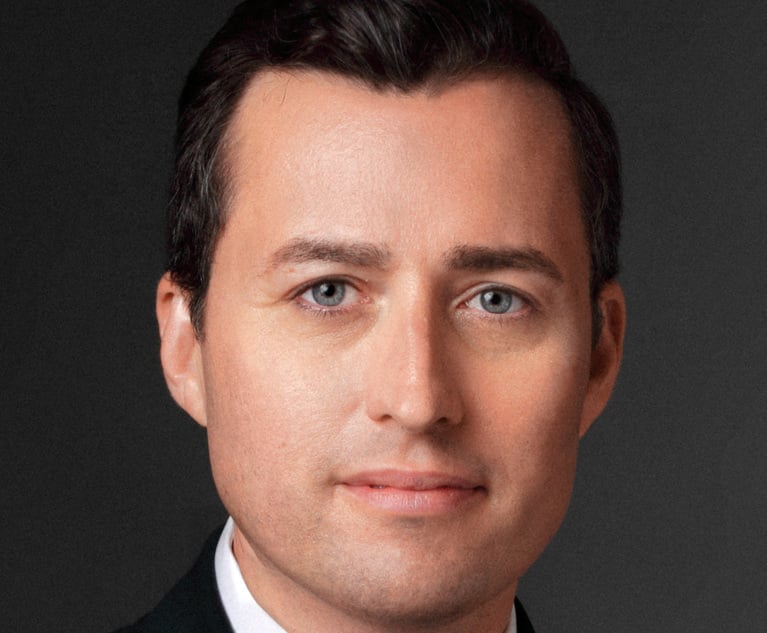The Coming Wave of Plastic Liabilities and Insurance Coverage
If a business manufactures plastic products or products that contain microplastics, it could face claims from individuals alleging bodily injuries or diseases from plastic exposure or microplastic ingestion. These risks may be mitigated by insurance.
May 29, 2020 at 02:40 PM
7 minute read
 According to the World Economic Forum, plastic production has increased twenty-fold since 1964. This increased production, coupled with insufficient waste management protocols and the one-time use of most plastic products, has led to a global threat: plastic pollution. Indeed, plastic waste has infiltrated the world's oceans and lands and has become a potential hazard to our environment and human health.
According to the World Economic Forum, plastic production has increased twenty-fold since 1964. This increased production, coupled with insufficient waste management protocols and the one-time use of most plastic products, has led to a global threat: plastic pollution. Indeed, plastic waste has infiltrated the world's oceans and lands and has become a potential hazard to our environment and human health.
Recently, the plastic pollution threat has been compounded by the discovery of microplastics—small plastic particles that result from the breakdown of human-made plastics, typically measuring less than 5 millimeters.
Microplastics are now believed to exist everywhere, including in our water and food supplies. A study by the University of Newcastle, Australia, suggests that an average person could be ingesting approximately 5 grams of plastic every week—the equivalent of a credit card's worth of microplastics. And the June 2019 issue of the journal of Environmental Science and Technology reported that "Americans consume an estimated 39,000 to 52,000 microplastic particles per year from seafood, water, sugars, salts, and alcohol alone."
The long-term effects of microplastic ingestion on human health are currently unknown. In September 2019, the World Health Organization stated that microplastics "don't appear to pose a health risk at current levels," but cautioned that the available information was limited and more research was needed to determine how microplastics effected human health.
In the meantime, the current research on plastic's chemical makeup and its effect on human health is concerning. A November 2019 report by the UN Environmental Programme discussed studies that found that additives in plastic are known to disrupt animals' hormonal systems and that the possible impacts on human health include lung inflammation, carcinogenicity, and gene mutation.
While the current research is limited, as more studies are conducted, specific chemicals in plastic products are linked to bodily harm, and the ingestion of microplastics is better understood, businesses that are responsible or even potentially responsible for an individual's exposure to plastics could face a range of liabilities. If a business manufactures plastic products or products that contain microplastics, it could face claims from individuals alleging bodily injuries or diseases from plastic exposure or microplastic ingestion. These risks may be mitigated by insurance.
Most businesses already purchase Commercial General Liability (CGL) policies (sometimes referred to as "litigation insurance") to provide coverage for the costs incurred defending and reasonably resolving lawsuits seeking to hold them liable for, among other things, alleged bodily injury and property damage. A business's CGL policy is the first place it should look if it is facing claims of bodily injury related to plastic exposure.
CGL policies obligate the insurer to pay the amounts that the insured becomes legally obligated to pay as damages up to the policy's aggregate limit. They also generally impose on the insurer a duty to defend the insured against suits seeking those damages. In addition to coverage for indemnity and defense costs, CGL policies may also cover the steps taken to prevent or reduce the chances that third parties or a business's own employee are exposed to plastic waste and microplastics. To trigger that coverage, however, there generally needs to be an allegation or possibility of "bodily injury," resulting in "damages" caused by an "occurrence." The "bodily injury" must take place "during the policy period."
An "occurrence" is typically defined as "an accident, including continuous or repeated exposure to substantially the same general harmful conditions." In cases involving toxic torts, such as asbestos (and someday plastics), determining the "occurrence" is not always straightforward because bodily injury caused by exposure to toxins, for example, can happen over time, and the date on which an injury manifests itself may have no relation to the date(s) of exposure. Courts have developed "trigger" theories to determine the policy period(s) in which "bodily injury" "occurred" in this context. Many look at when injury "in fact" occurred, noting that the injury process that ultimately results in disease can start decades earlier—meaning that all policies in existence from first exposure to a substance through the date that symptoms appear (and later, if the injury process continues) can apply. Thus, coverage may depend on the injury or disease process—whether it is instantaneous or a process that goes on for years.
Insurers may contend that claims alleging bodily injury from plastics are excluded from CGL policies because the standard CGL policy contains a pollution exclusion. However, the typical CGL pollution exclusion does not define "pollutants" to include "plastics" and arguably, plastics are not traditionally regarded as a "pollutant" or "contaminant." If the insurer specifically intended to include plastics as a pollutant, it could have done so, and its failure to do so is evidence that plastic was not intended to be excluded.
Further, if facing third-party claims alleging bodily injury or disease from plastic exposure or ingestion, businesses should pay close attention to what policy applies because this often turns on what insurer duty is at issue. For example, an insurer's duty to defend or to pay defense costs usually depends on the so-called "potential for coverage," meaning that allegations of injury (or even vagueness allowing for the possibility of injury) in each policy period may trigger an insurer's duty to defend. This would include any allegations of bodily injury from plastics, such as microplastic ingestion.
By comparison, an insurer's duty to indemnify for settlements or judgments may depend on when injury is deemed to have occurred. But, whatever the case, policies in effect years before it is determined exactly what, if any, injuries are caused by ingestion of microplastics may provide coverage. This means that policies issued decades ago may provide coverage, as well as policies issued today. Thus, it is important for insureds to preserve current and historic insurance policies. These policies may provide expansive coverage worth tens, if not hundreds, of millions of dollars—just as historic policies have turned out to provide billions of dollars of coverage for asbestos, environmental, and other long-term/cumulative trauma injuries.
While CGL insurance is arguably the first place a business should look when confronted with claims by individuals alleging injuries, sicknesses, or diseases from plastic exposure or microplastic ingestion, businesses should also consider the nature of their business and range of potential liabilities.
For example, if a business directly manufactures plastics or collects plastic waste, they should be wary of bodily injury claims by employees and should consider employer liability coverage. On the other hand, if a business produces products that may contain microplastics (e.g., plastic water bottles), it should consider product liability and product recall insurance. And if either of these businesses have directors and officers that could face suits by shareholders that duties were breached in the management of plastic waste or microplastics, these businesses should consider directors and officers insurance.
In addition to the effects of plastics on human health, as more research is done on the effects of plastics on the environment, businesses may face costs associated with plastic waste removal. The CGL policy may provide coverage for property damage arising from the presence of plastics. In addition, the standard "all risk" property policy may cover the costs of cleaning up soil or water that has been affected by plastic. These policies may obligate the insurer to pay the costs of removing the property that has been contaminated and the contaminant itself.
To maximize the possibility of coverage and preserve their rights under insurance policies, businesses should review all potentially applicable insurance policies and all conditions, exclusions and time restraints on coverage in those policies. They should also note that while there are standard forms of policies, such as the "standard" CGL policy, most policies have variations in policy language and endorsements modifying "form" language. This is why businesses should carefully review policies and never assume that something, such as plastics, is excluded.
Mikaela Whitman is a partner in Pasich LLP's New York office and a member of the firm's insurance recovery practice. Her practice focuses on the representation of insureds in all phases of insurance coverage recovery, from pre-suit negotiations through alternative dispute resolution and litigation. She can be contacted at [email protected].
This content has been archived. It is available through our partners, LexisNexis® and Bloomberg Law.
To view this content, please continue to their sites.
Not a Lexis Subscriber?
Subscribe Now
Not a Bloomberg Law Subscriber?
Subscribe Now
NOT FOR REPRINT
© 2025 ALM Global, LLC, All Rights Reserved. Request academic re-use from www.copyright.com. All other uses, submit a request to [email protected]. For more information visit Asset & Logo Licensing.
You Might Like
View All
Uber Files RICO Suit Against Plaintiff-Side Firms Alleging Fraudulent Injury Claims
3 minute read
Insurance Company Sues Over 180 Health Care Providers for Fraud Under RICO
3 minute read
New York Court of Appeals Tightens Pleading Standards Against Insurance Policyholder
7 minute read
Amid Growing Litigation Volume, Don't Expect UnitedHealthcare to Change Its Stripes After CEO's Killing
6 minute readTrending Stories
- 1Thursday Newspaper
- 2Public Notices/Calendars
- 3Judicial Ethics Opinion 24-117
- 4Rejuvenation of a Sharp Employer Non-Compete Tool: Delaware Supreme Court Reinvigorates the Employee Choice Doctrine
- 5Mastering Litigation in New York’s Commercial Division Part V, Leave It to the Experts: Expert Discovery in the New York Commercial Division
Who Got The Work
J. Brugh Lower of Gibbons has entered an appearance for industrial equipment supplier Devco Corporation in a pending trademark infringement lawsuit. The suit, accusing the defendant of selling knock-off Graco products, was filed Dec. 18 in New Jersey District Court by Rivkin Radler on behalf of Graco Inc. and Graco Minnesota. The case, assigned to U.S. District Judge Zahid N. Quraishi, is 3:24-cv-11294, Graco Inc. et al v. Devco Corporation.
Who Got The Work
Rebecca Maller-Stein and Kent A. Yalowitz of Arnold & Porter Kaye Scholer have entered their appearances for Hanaco Venture Capital and its executives, Lior Prosor and David Frankel, in a pending securities lawsuit. The action, filed on Dec. 24 in New York Southern District Court by Zell, Aron & Co. on behalf of Goldeneye Advisors, accuses the defendants of negligently and fraudulently managing the plaintiff's $1 million investment. The case, assigned to U.S. District Judge Vernon S. Broderick, is 1:24-cv-09918, Goldeneye Advisors, LLC v. Hanaco Venture Capital, Ltd. et al.
Who Got The Work
Attorneys from A&O Shearman has stepped in as defense counsel for Toronto-Dominion Bank and other defendants in a pending securities class action. The suit, filed Dec. 11 in New York Southern District Court by Bleichmar Fonti & Auld, accuses the defendants of concealing the bank's 'pervasive' deficiencies in regards to its compliance with the Bank Secrecy Act and the quality of its anti-money laundering controls. The case, assigned to U.S. District Judge Arun Subramanian, is 1:24-cv-09445, Gonzalez v. The Toronto-Dominion Bank et al.
Who Got The Work
Crown Castle International, a Pennsylvania company providing shared communications infrastructure, has turned to Luke D. Wolf of Gordon Rees Scully Mansukhani to fend off a pending breach-of-contract lawsuit. The court action, filed Nov. 25 in Michigan Eastern District Court by Hooper Hathaway PC on behalf of The Town Residences LLC, accuses Crown Castle of failing to transfer approximately $30,000 in utility payments from T-Mobile in breach of a roof-top lease and assignment agreement. The case, assigned to U.S. District Judge Susan K. Declercq, is 2:24-cv-13131, The Town Residences LLC v. T-Mobile US, Inc. et al.
Who Got The Work
Wilfred P. Coronato and Daniel M. Schwartz of McCarter & English have stepped in as defense counsel to Electrolux Home Products Inc. in a pending product liability lawsuit. The court action, filed Nov. 26 in New York Eastern District Court by Poulos Lopiccolo PC and Nagel Rice LLP on behalf of David Stern, alleges that the defendant's refrigerators’ drawers and shelving repeatedly break and fall apart within months after purchase. The case, assigned to U.S. District Judge Joan M. Azrack, is 2:24-cv-08204, Stern v. Electrolux Home Products, Inc.
Featured Firms
Law Offices of Gary Martin Hays & Associates, P.C.
(470) 294-1674
Law Offices of Mark E. Salomone
(857) 444-6468
Smith & Hassler
(713) 739-1250






